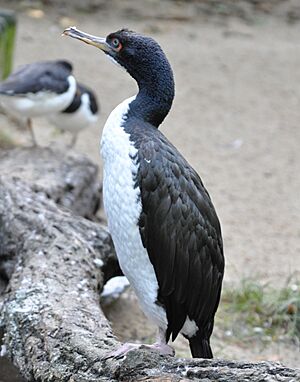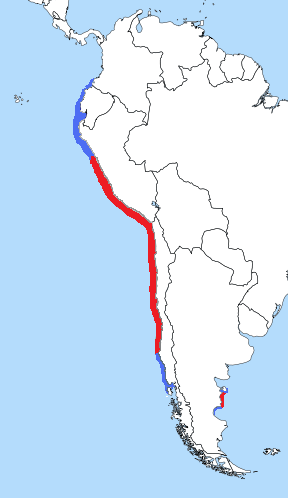Guanay cormorant facts for kids
Quick facts for kids Guanay cormorant |
|
|---|---|
 |
|
| Conservation status | |
| Scientific classification | |
| Genus: |
Leucocarbo
|
| Species: |
bougainvillii
|
 |
|
| Distribution map of the guanay cormorant | |
| Synonyms | |
|
Phalacrocorax bougainvillii |
|
The guanay cormorant (scientific name: Leucocarbo bougainvillii) is a type of cormorant bird. It lives along the Pacific coast of Peru and northern Chile. Sometimes, these birds travel further north to Ecuador, Panama, and Colombia. They might do this when there isn't enough food, especially during El Niño events.
Guanay cormorants like to live near shallow ocean waters and on rocky shores. They are known for producing a lot of guano, which is bird droppings used as fertilizer.
Contents
What Does a Guanay Cormorant Look Like?
The guanay cormorant is a medium-sized bird. It measures about 78 centimeters (about 31 inches) from its beak to its tail. Its beak is grayish, with some red near its face.
Colors and Features
This bird has a red face and a green ring around its eyes. Its feet are a pretty rosy color. The head, neck, and back of the bird are black. The outer parts of its thighs are also black.
The throat, chest, and belly of the guanay cormorant are white. When it's breeding season, the bird gets a few white feathers on the sides of its head and neck.
Life Cycle and Reproduction
Guanay cormorants can breed all year round. However, they have the most babies in November and December. They build their nests using guano (their droppings).
Nesting Habits
They build their nests on flat areas. These places are usually on islands off the coast or on remote pieces of land sticking out into the sea. These birds live in very large groups called colonies. There can be up to three nests in just one square meter!
A female guanay cormorant usually lays two or three eggs. Each egg is about 63 millimeters long and 40 millimeters wide.
What Do Guanay Cormorants Eat?
The guanay cormorant mainly eats small fish. Their favorite foods are the Peruvian anchoveta and the Peruvian silverside. These fish are common in the cold Humboldt Current of the Pacific Ocean.
Importance of Their Diet
Because they eat so many fish, guanay cormorants are the main producers of guano. This guano has been a very important natural fertilizer for people in the Andes mountains for a long time.
Protecting the Guanay Cormorant
The number of guanay cormorants has been going down. In 1984, there were about three million birds. Since then, their population has dropped by about 30 percent.
Threats to Their Survival
There are a few reasons for this decline. One big reason is habitat loss. This means the places where they live are being damaged or disappearing. Another problem is over-fishing. When too many fish are caught by humans, there isn't enough food left for the cormorants.
Because of these threats, the IUCN (International Union for Conservation of Nature) lists the guanay cormorant as "near threatened." This means they could become endangered if we don't protect them.
History of Their Name
The scientific name of the guanay cormorant, bougainvillii, honors a French explorer named Louis Antoine de Bougainville.
Ancient Protection
The bird's droppings (guano) were so important to the ancient Inca people in the Andes. The Inca rulers protected these birds very strictly. It is said that disturbing the cormorants in any way could be punished by death! The common name "guanay" comes from a Spanish word, guanae, which is related to the word "guano."
Images for kids



